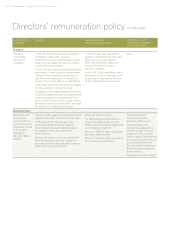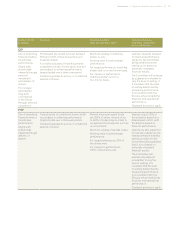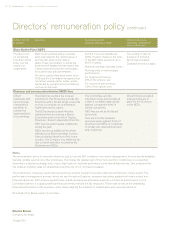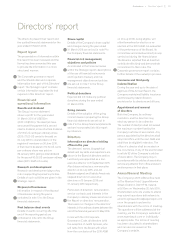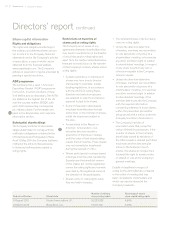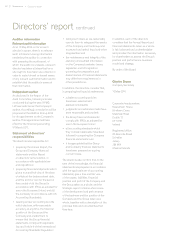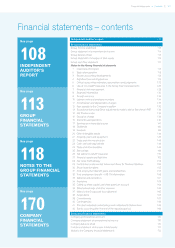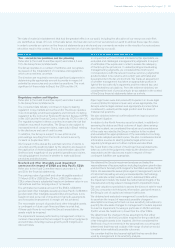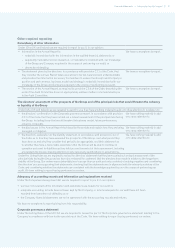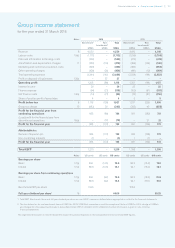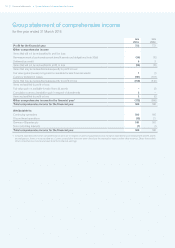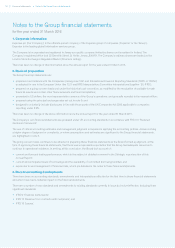Experian 2016 Annual Report Download - page 111
Download and view the complete annual report
Please find page 111 of the 2016 Experian annual report below. You can navigate through the pages in the report by either clicking on the pages listed below, or by using the keyword search tool below to find specific information within the annual report.
109•Financial statements Independent auditor’s report
The risks of material misstatement that had the greatest effect on our audit, including the allocation of our resources and effort,
are identified as ‘areas of focus’ in the table below. We have also set out how we tailored our audit to address these specific areas
in order to provide an opinion on the financial statements as a whole and any comments we make on the results of our procedures
should be read in this context. This is not a complete list of all risks identified by our audit.
Area of focus How our audit addressed the area of focus
Tax – uncertain tax positions and tax planning
Refer also to the Audit Committee report and notes 4, 5 and
15 to the Group financial statements.
The Group operates in a number of territories and recognises
tax based on the interpretation of local laws and regulations
which are sometimes uncertain.
The directors are required to exercise significant judgments in
determining the appropriate amount to provide in respect of
potential tax exposures and uncertain tax positions. The most
significant of these relate to Brazil, the USA and the UK.
In conjunction with our UK and international tax specialists, we
evaluated and challenged management’s judgments in respect
of estimates of tax exposures in order to assess the adequacy
of the Group’s tax provisions. In understanding and evaluating
management’s judgments, we considered the most recent
correspondence with the relevant revenue services, judgmental
positions taken in tax returns and current year estimates and
developments in the tax environment. We made an assessment
of whether management has taken an appropriate position in
light of the tax authority’s arguments and the relevant law, and
also checked key calculations. From the evidence obtained, we
considered the level of provisioning to be acceptable in the context
of the Group financial statements taken as a whole.
Regulatory matters and litigation
Refer also to the Audit Committee report and notes 5 and 40
to the Group financial statements.
The consumer data industry continues to have increasing
regulation in key markets across the world. The Group operates
in an increasingly scrutinised regulatory environment, including
regulation by the Consumer Financial Protection Bureau (‘CFPB’)
in the USA and the Financial Conduct Authority (‘FCA’) in the UK.
The regulatory regime in these countries increases the risk that
violations may result in penalties. The Group is also subject to
increased levels of consumer claims, especially in Brazil relating
to the disclosure and use of credit scores.
In addition, the Group is subject to new actions and
proceedings resulting from the North America security
incident in September 2015.
We focused on this area as the eventual outcome of claims is
uncertain and the positions taken by the directors are based on
the application of material judgment and estimation about the
likelihood and magnitude of any potential penalties and claims,
including judgment involved in whether to make additional
provisions and disclosures.
Open legal cases were discussed with Experian’s in-house legal
counsel, Global Compliance team and, where appropriate, the
Group’s external legal advisers and appropriate documentation
considered to understand the legal position and the basis of
material risk positions.
We also obtained external confirmations from legal counsel on
significant litigation.
In relation to the North America security incident, in addition to
assessing the status and likely outcome of legal claims arising
from the incident, we considered the nature and completeness
of the costs recorded by the Group in relation to the incident
and evaluated the appropriateness of the associated accounting
treatments adopted and disclosures. We also considered external
information sources to identify potential legal actions and
regulatory findings and no further matters were identified.
We found that in the context of the Group financial statements
taken as a whole the judgments made by the directors were
reasonable and the disclosures made in respect of these
contingent liabilities are appropriate.
Goodwill and other intangible asset impairment
assessment in respect of EMEA and Asia Pacific CGUs
Refer also to the Audit Committee report and notes 4, 5, 19
and 20 to the financial statements.
The carrying value of goodwill and other intangible assets at
31 March 2016 is US$5,629m. Of this, US$5,123m relates to
CGUs where there is substantial headroom between value-in-use
calculations and the carrying value of net assets.
The estimated recoverable amount of the EMEA (US$247m
goodwill and other intangible assets) and Asia Pacific (US$163m
goodwill and other intangible assets) CGUs shows there is low
headroom and some risk of impairment if growth assumptions
and forecasted improvement in margin are not achieved.
The recoverable amount of goodwill and other intangible assets
is contingent on future cash flows and there is a risk that,
if these cash flows do not meet the Group’s expectations, the
assets might be impaired.
The impairment reviews performed by management contain a
number of assumptions that are subject to significant judgments
and estimates including revenue growth, profit margins and
discount rates.
We obtained the Group’s impairment analyses and tested the
reasonableness of key assumptions including long-term growth rates
and short-term forecast profit margins for the EMEA and Asia Pacific
CGUs. We assessed the assumptions against management’s record
of historical forecasting accuracy and evaluated the methodology
used to allocate central overhead costs to individual CGUs within
the impairment models. We tested the mathematical integrity of the
forecasts and carrying values in management’s impairment model.
We used valuations specialists to assess the discount rate for each
CGU by comparison to third party information, past performance,
the Group’s cost of capital and relevant risk factors.
We obtained and evaluated management’s sensitivity analyses
to ascertain the impact of reasonably possible changes in
assumptions and we performed our own sensitivity calculations to
quantify the downside changes to management’s models required
to result in impairment, focusing in particular on EMEA and Asia
Pacific where the headroom is lower than the other CGUs.
We determined the change in those assumptions that either
individually or collectively would be required for the goodwill and
other intangible assets to be impaired. We then considered the
likelihood of such movements in key assumptions occurring and
determined that these sat outside of the range of what we would
consider to be realistically possible outcomes.
We consider that the disclosures highlight the key sensitivities
used by management in its sensitivity analysis.



